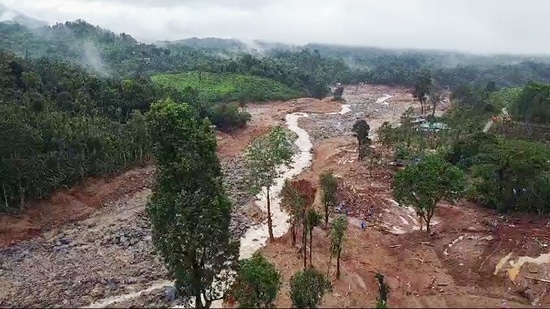The landslide in Kerala’s Wayanad this week was not the result of any one factor. Several inter-related factors — intense rain, the susceptibility of the area to landslides, and unplanned development in a landslide-prone region – worked together to inflict a death toll, which is nearing 300 (as of Friday). While most of this was reported here, the rain in other parts of Kerala also deserves attention. This is because they were also experiencing floods on July 30 and the state as a whole is experiencing long-term changes in monsoon rain.
An HT analysis published in the immediate aftermath of the Wayanad landslide (it took place in the early hours of July 30) showed that Wayanad was not the rainiest place on the day. However, a comparison of the total rain up to July 30 this year with the 1971-2020 average — considered the Long Period Average (LPA) or the normal for rain currently by the India Meteorological Department (IMD) – shows that Wayanad indeed received a big surplus in July. As the accompanying map shows, the degree of surplus in Wayanad in July is matched only by Palakkad, although large parts of the state have a surplus
To be sure, in the days leading up to the series of disasters on July 30 (Wayanad was only the deadliest), the area under surplus rain in Kerala was increasing. For example, for the July 1-July 30 period, 26% of the state’s area had a surplus of at least 60%, classified as “large excess” by IMD. In the week ending July 30, such area covered 74% of the state. In the three days ending July 30, this area increased to 94% of the state.
A big surplus in late July covering most of Kerala does not, however, mean that most of the state now has surplus rain in the season overall. The monsoon season begins officially on June 1. Despite the surplus in July, 56% of the state has received rain within 20% of the LPA, which is classified as “normal” by the IMD
The trends shown for Kerala in the 2024 monsoon season are also part of a long-term trend. IMD’s gridded data gives rainfall since 1901. This shows that the 30-year rolling average of total monsoon rain over Kerala (it ends officially on September 30) has been decreasing almost consistently over time: from around 1,996 mm in the 30-year period ending 1930 to 1,687 mm in the 30-year period ending 2023. The normal rain seen in 2024 is, therefore, from an already lower LPA than in the early 20th century.
To be sure, the total June-September rain decrease over Kerala has not affected all months equally. For example, July, the rainiest month in the season, has seen rain decline long-term. The 2024 rain in July is therefore an aberration compared to this long-term trend. The trend in July is also seen in June and August to some extent, but not necessarily in September. September rain has seen a sharp upward trend in recent years. This suggests that not only is monsoon drying up in Kerala, but it is also shifting towards the latter half of the season. This explains why a large part of the state has just normal rain so far in the season despite July bucking its long-term trend.
